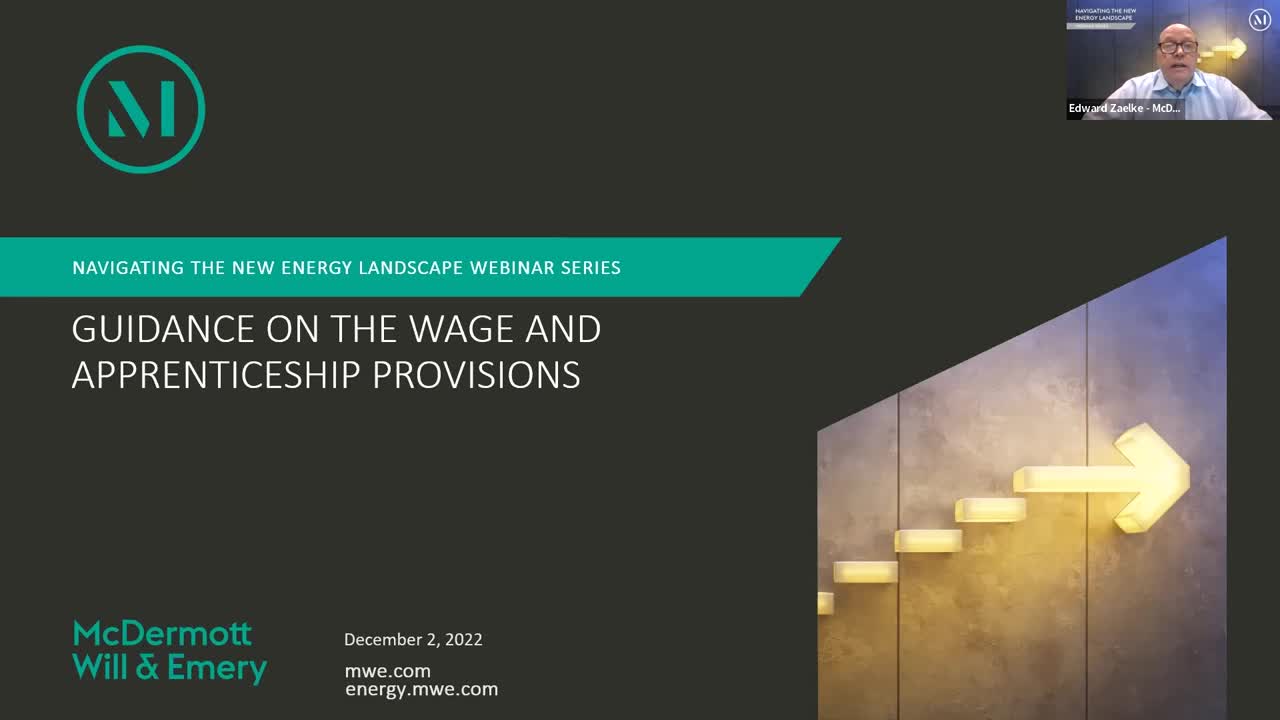Large, utility-scale US Department of Defense (DoD) renewable energy projects, which have not been pursued by the DoD for more than six years, may finally be back. The Defense Innovation Unit (DIU) is actively seeking solutions that would allow the US Department of the Air Force to deploy renewable energy systems and accompanying energy-resilient projects (including energy storage projects) quickly and cost-effectively. The Air Force is seeking a large lead sponsor to provide energy solutions that will meet the demand for on-base utility systems that are resilient, carbon-free, efficient and economical. The DIU and Air Force want to work with an entity that can adequately address these demands at an enterprise scale.
Thank You to Our Readers
We greatly appreciate our readers over the past year and are pleased to share that we were recently recognized for our energy thought leadership in the 2023 JD Supra Readers’ Choice Awards, which acknowledge top authors and firms for their thought leadership in key topics during all of last year.
Carl Fleming, a regular contributor to Energy Business Law, was recognized as a “Top Author” for energy. His principal areas of practice are renewable energy and private equity, and he provides legal, commercial and strategic advice on the development, purchase and sale and financing of renewable energy projects in wind, solar, energy storage, electric vehicles and other low carbon solutions.
Through our various blogs, thought leadership pieces and energy-focused events, we are dedicated to maintaining our position as a leading firm for energy work and keeping clients abreast of significant and relevant topics in the industry.
Understanding Energy Storage
One of the US Department of Commerce’s (Commerce) signature contributions to Power Africa has been the Understanding handbook series developed by its Office of the General Counsel’s Commercial Law Development Program (CLDP). This open-source and plain-language knowledge library now includes six handbooks explaining a range of essential topics in power project contracts, financing and procurement. In recent years, the Understanding series has expanded to focus on unique challenges in Africa’s energy market, such as the complex nature of private participation in transmission projects. With 65,000 copies in print and tens of thousands more copies downloaded online, the Understanding series has become a trusted resource in Africa’s power project community.
The most recent addition to the Understanding series, Understanding Energy Storage, comes at a critical time in both the development of the continent and the effort to combat climate change globally. The hope is that this handbook will contribute to Power Africa’s efforts to catalyze new energy storage investment as a core component of overall market development. This handbook supports the Commerce’s Renewable Energy and Energy Efficiency Advisory Committee’s recommendations on (1) Clean Tech Export Competitiveness Strategy, (2) Energy Equity and (3) Technology Risk Mitigation and Financing; and advances the US International Climate Finance Strategy.
This handbook is from Commerce’s Commercial Law Development Program and is co-authored by McDermott Associate Seth Doughty.
Key Takeaways | Guidance on the Wage and Apprenticeship Provisions
The Navigating the New Energy Landscape webinar series came back last week for a special bonus session that focused on the just-released Internal Revenue Service (IRS) guidance on the wage and apprenticeship provisions included in the Inflation Reduction Act of 2022 (IRA).
During this webinar, McDermott Partners Heather Cooper and Philip Tingle walk through the new guidance, covering key issues and drilling down into the impact of the 60-day countdown clock for which developers have to implement these provisions or face the loss of critical tax benefits for their renewable energy projects.

Below are key takeaways from the discussion:
1. IRS Notice 2022-61 provides additional guidance on the prevailing wage and apprenticeship requirements included in the IRA, which apply to a broad range of energy tax credits. Projects that do not meet these requirements potentially face an 80% reduction to any applicable energy tax credits. However, due to the 60-day delay between the release of the guidance and when the rules take effect, projects that begin construction before January 30, 2023, will not be subject to the requirements.
2. Notice 2022-61 also provides clarification (largely by reference) to existing US Department of Labor (DOL) regulations and prior IRS guidance. For example, it clarified that the existing IRS framework for determining the beginning of construction will be preserved. Other developments include a contemporaneous recordkeeping requirement necessary to establish compliance with the prevailing wage and apprenticeship requirements, clarification on the good faith effort exception to the apprenticeship requirements, and a new DOL email address for questions regarding prevailing wage determinations.
3. Despite this guidance, many questions remain unanswered. While many key definitions and rules are clarified by reference to DOL rules, this has not eliminated uncertainty regarding their implementation. McDermott’s energy & project finance team is working closely with the Firm’s employment team to tap into their vast experience with the DOL.
4. These developments raise many new considerations for developers. Those that can start construction before January 30 may wish to determine how to meet the beginning of construction requirements promptly and effectively before the guidance takes effect. Those that cannot start construction before January 30 will need to consider how to manage potential risks that arise from the new rules. This could require additional transactional scrutiny when drafting and negotiating around compliance.
To access past webinars in the Navigating the New Energy Landscape series and to begin receiving Energy updates, including invitations to the webinar series, please click here.
Key Takeaways | Carbon Capture Gets a Long Runway for Development
Featured prominently in the Inflation Reduction Act of 2022 (IRA), carbon capture, utilization and storage (CCUS) is one segment of the energy industry that could most benefit from incentivized development. On November 17, McDermott Partners Parker Lee and Philip Tingle were joined by Laura Gieseke, senior counsel at Western Midstream, and Spencer English, director at Piper Sandler, for a discussion on the current CCUS market and how potential benefits in the IRA might play out in future CCUS development projects.

Below are key takeaways from the discussion:
1. Progress in the CCUS market requires buy-in from the oil and gas industry. This has been the case thus far given the industry’s existing technologies and desire to reduce its carbon outputs. New incentives within the IRA, such as direct pay credits, are expected to spur further investment.
2. The three primary components of CCUS are physical capture, transportation of carbon by pipeline and sequestration systems. There has been more investment and research into physical capture and transportation as those projects deal with pre-existing structures within the oil and gas industry. While direct air capture is not as popular as other carbon capture measures, the industry is devoting time to study the feasibility of such projects.
3. The IRA allows for developers to treat amounts paid in excess of their tax liability for certain tax credits as a refundable payment and receive a cash refund from the Internal Revenue Service (IRS). Specifically, Section 45Q permits both tax-exempt and non-tax-exempt entities to take advantage of this incentive for carbon oxide sequestration credits. This “direct pay” allows CCUS developers to monetize tax credits without partnering with tax equity investors and will allow for increasing the scale of CCUS projects. This provision will remain in effect until 2033. The monetization mechanism for the direct pay credits still needs to be developed and put into practice.
4. There are important questions that the IRS needs to consider during its comment period that will shape the future of the CCUS market and financing for it. For example: How is carbon sequestration defined? If an entity avoids producing CO2, does that qualify as carbon sequestration? How do we verify sequestration? How is sequestration documented?
5. Tax equity investors have a good sense of potential risks for wind and solar projects, but there is a desire to diversify into different technologies. While direct pay will permit the oil and gas industry to proceed with CCUS projects without tax equity partners, the industry expects tax equity partners to join down the road to allow for maximum utilization of the available tax credits.
To access past webinars in the Navigating the New Energy Landscape series and to begin receiving Energy updates, including invitations to the webinar series, please click here.



